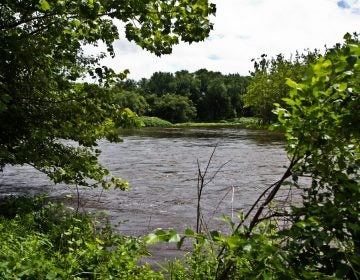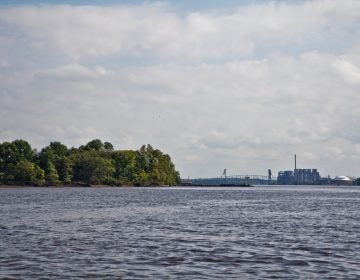Oxygen in Delaware River falls as water temperature rises
Although the water is a lot cleaner than it was then, activists say the cleanup is unfinished, as shown by the oxygen numbers for the past three summers.

The Delaware River at the Ben Franklin Bridge between Camden and Philadelphia. (Kelly Kiernan/Unsplash)
This story originally appeared on NJ Spotlight.
The amount of oxygen in the Delaware River south of Camden dropped below a regulatory limit during each of the last three summers, according to data from the U.S. Geological Survey, making it harder for resident and migratory fish to breed, and undermining the benefits of the river’s cleanup over the past half-century.
The data shows that levels of dissolved oxygen, a key determinant of a river’s ability to support fish, fell in some places to below 3.5 milligrams per liter, a level that was set by the Delaware River Basin Commission (DRBC) in the 1960s when the agency was trying to clean up a waterway that was, in the regulator’s own words, “an open sewer.”
Although the water is a lot cleaner than it was then, activists say the cleanup is unfinished, as shown by the oxygen numbers for the past three summers — when higher water temperatures have depleted oxygen.
The recent low point came in 2020 when dissolved oxygen dropped as low as 2.8 milligrams per liter in the river at Commodore Barry Bridge linking New Jersey with Chester, Pennsylvania, and 3.3 milligrams per liter at the Ben Franklin Bridge connecting Camden with Philadelphia, the USGS data shows.
Four environmental groups, led by Delaware Riverkeeper Network, last month renewed an appeal to the basin commission to raise its dissolved oxygen benchmark in the river to 6.3 milligrams per liter, or almost double the current standard. Being required to meet that standard, the activists say, would force wastewater treatment plants — whose output is largely responsible for the oxygen depletion — to install a technology called nitrification that would reduce the ability of nitrogen in plant discharges to reduce oxygen levels.
At-risk fish
Fish species that are at risk, the activists say, include American shad, striped bass and the critically endangered Delaware River population of Atlantic sturgeon, of which only a few hundred are thought to remain.
“While dissolved oxygen can remain relatively abundant in some years, such as the summer of 2014, the estuary’s overall fate, and the fate of such species as the critically endangered Atlantic sturgeon, are left to chance,” the environmental groups wrote in a letter to the DRBC on Sept. 9. They said that the higher temperatures resulting from climate change may have played a role in the oxygen depletion.
The regulator, which manages water flows for the four basin states — New Jersey, New York, Pennsylvania and Delaware — has been studying whether water quality can be improved to support fish breeding since at least 2017, and last year extended the study period until September 2022 because of delays caused by the COVID-19 pandemic.
In 2018, the DRBC commissioned the Academy of Natural Sciences of Drexel University to study the dissolved oxygen levels needed by the river’s fish species. The study concluded that dissolved oxygen levels of 6 to 8 milligrams per liter “would be optimal” for the survival and success of key species in the estuary.
In their letter, the environmental groups acknowledged there has been a significant improvement in the river’s water quality since the 1960s but said the DRBC’s existing standard was never intended to protect the spawning of resident and migratory fish that now occurs every year in a tidal stretch of the river between the Tacony-Palmyra Bridge and Wilmington, Delaware.
Although there has been a recovery in fish numbers and variety since severe pollution in the 20th century created a “dead zone” in the river’s oxygen levels near Camden, the portion of oxygen depletion that’s caused by nitrogen discharges has not improved, and represents a major piece of unfinished business in the long-term cleanup of the river, said Maya van Rossum, who heads the Delaware Riverkeeper Network.
“Just because populations have been allowed to rebound to a certain extent, that does not negate the important damage being inflicted by a lack of oxygen, and that is very much a limiting factor in the population being able to fully restore,” she said.
Improving the oxygen standard
Erik Silldorff, restoration director for the riverkeeper network, said the existing dissolved oxygen standard of 3.5 milligrams per liter was set in 1967 as a compromise, and is no longer appropriate, given that the estuary is now routinely used by migrating fish that would not have survived the severe pollution of the mid-20th century.
“They knew that it wasn’t going to protect fish, particularly in their early life,” he said. “It was the best they thought they could do, and at some point they hoped they could do better in the future.”
The groups reiterated a petition by Delaware Riverkeeper Network in March that asked the basin commission to raise the oxygen standard to attain a designated use of “maintenance and propagation” for the affected fish species — a goal set by the federal Clean Water Act of 1972.
“Lethal oxygen conditions occur only because we have failed to take action and reduce pollutant loads using these conventional technologies,” according to the letter, which was also signed by Environment New Jersey, Clean Air Council and PennFuture.
Basin commission spokeswoman Kate Schmidt declined to confirm that oxygen levels had fallen below the agency’s standard in the estuary for the summers of 2019, 2020 and 2021, as highlighted by the environmental groups. She said the agency’s response will be included when it replies to the riverkeeper network’s letter, but that hasn’t happened yet.
“Because of the myriad of letters that we get from DRN, and the fact that our response also needs to be run through the five Commissioners (and/or their respective alternates), it takes time,” she said.
WHYY is your source for fact-based, in-depth journalism and information. As a nonprofit organization, we rely on financial support from readers like you. Please give today.






